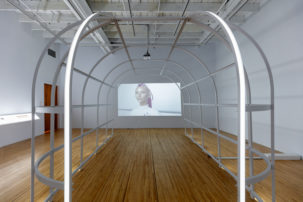At first look, Kim Ondaatje’s monumental Factory paintings, the most prominent series among her exhibition “Paintings 1950–1975” at the University of Toronto Art Centre, could have been painted yesterday. Shell Oil Refinery depicts a flatbed truck bearing the iconic red and yellow logo. In the background is the bleak landscape of the refinery: bulbous white holding tanks and black towers amid a white field of snow and icy blue sky. Considering the work one might contemplate a subject that’s flooding the news this summer: rising oil and gas prices. Yet it was created nearly 40 years ago.
To be clear, there is nothing about Ondaatje’s Factory paintings that make them easy condemnations of industry. They’re subtler than that, though Ondaatje’s words make her own feelings clear enough. To curator Lora Senechal Carney, Ondaatje related a story—now part of the exhibition’s accompanying text—about her first visit to a cement factory in southern Ontario. The air, she says, was hazy with dust from the factory, and berry bushes and tree leaves were coated in a film of white powder. The experience stuck with her.
The works draw you in in another way, too. Most of the canvases’ surfaces are covered in oil paint, but the detailed parts are constructed of cut-outs made from masking tape and other materials. The result is an ultra-thin relief that gives each scene a charming illustrative quality. Inco Slag Train is probably best in this respect, calling up childhood fascinations with model railways, each rail car and mid-ground telephone pole intricately rendered in this way.
| <img src="/online/reviews/2008/07/31/kim_ondaatje2_448.jpg" alt="Kim Ondaatje Wales #1 1966 Private Collection” style=”border: none; clear: none;” /> | |
|
Kim Ondaatje Wales #1 1966 Private Collection |
Accompanying the Factory paintings is Ondaatje’s 1973 art film Factories. Documenting a plant near Sudbury, the camera zooms in on heavy machinery moving animal-like through mounds of material. Then the camera pans through velvety, billowing clouds of steam and smoke from the plant’s stacks. As Carney points out, an apt comparison would be Edward Burtynsky’s stunning, thought-provoking documentary photography. Another might be Gordon Gordon Matta-Clark’s Fresh Kills, which similarly animated big trucks (on the Staten Island landfill) and panned fields of trash. Ondaatje’s film might be less vicious, but it’s riveting nonetheless.
Ondaatje’s other series are not given the same amount of space, but do help to reveal an artist who was long interested in investigating her surroundings. Carney also seeks to position Ondaatje as an artist absorbing the currents of late modernism while participating in a new movement—the London, Ontario, regional art scene. The Hill series and the House on Piccadilly series, which both came before Factory, are smaller-scale paintings playing with abstraction and perspective. The former are thick, blackish landscapes almost devoid of detail—the undulating lines of shield country are the subject. The House on Piccadilly series, on the other hand, appears relatively obsessed with detail. Ondaatje painted the stairwell (twice), the hallway, the kitchen and the cuckoo clock in her family’s rambling old house on the street of the same name.
Each series stands on its own, but it seems undoubtedly the Factory series that will engage viewers most today. Shimmering alternately with the heat of summer and the chilling winter wind, Ondaatje’s careful paintings are poignant documents of the Canadian landscape. (15 King’s College Circ, Toronto ON)
| <img src="/online/reviews/2008/07/31/kim_ondaatje3_448.jpg" alt="Kim Ondaatje Hearn Plant, Toronto Harbour 1974 Collection of Art Gallery of Ontario, Gift of David L. McQueen, Uxbridge, Ontario, 2005″ style=”border: none; clear: none;” /> | |
|
Kim Ondaatje Hearn Plant, Toronto Harbour 1974 Collection of Art Gallery of Ontario, Gift of David L. McQueen, Uxbridge, Ontario, 2005 |










